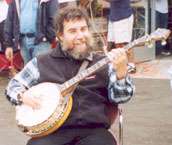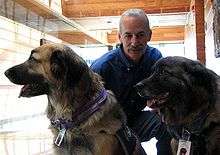Nano/Bio Interface Center
The Nano/Bio Interface Center is a Nanoscale Science and Engineering Center at the University of Pennsylvania. It specializes in bionanotechnology, combining aspects of life sciences and engineering,[1] with a particular focus in biomolecular optoelectronics and molecular motions, including developing new scanning probe microscopy techniques.[2][3] It offers a master's degree in nanotechnology. The center was established in 2004 with a US$11.6 million grant from the National Science Foundation, and received an additional $11.9 million grant in 2009.[4] By 2013 it had constructed a new facility, the Krishna P. Singh Center for Nanotechnology.[5]
Award for Research Excellence in Nanotechnology
The Award for Research Excellence in Nanotechnology is given by the Nano/Bio Interface Center each year to an outstanding researcher in nanotechnology.[6] The award is given each year at the center's NanoDay outreach event.[5]
| Year | Recipient | Institution | Rationale | |
|---|---|---|---|---|
| 2005 |  |
Horst Störmer | Columbia University | "[for having] worked extensively on the properties of two-dimensional electron sheets in semiconductors"[6] |
| 2006 |  |
Steven M. Block | Stanford University | "[for having] pioneered the use of laser-based optical traps (or “optical tweezers”) to study the nanoscale motions of individual biomolecules"[6] |
| 2007 | Charles M. Lieber | Harvard University | "[for having] pioneered the synthesis of a broad range of nanoscale materials, the characterization of the unique physical properties of these materials and the development of methods of hierarchical assembly of nanoscale wires, together with the demonstration of applications of these materials in nanoelectronics, nanocomputing, biological and chemical sensing, neurobiology, and nanophotonics"[6] | |
| Christoph Gerber | University of Basel | "[for having] focused on nanoscale science as a pioneer in scanning probe microscopy, making major contributions to the invention of the scanning tunneling microscope and the atomic force microscope (AFM)"[6] | ||
| 2008 | Naomi J. Halas | Rice University | "[for] inventing nanoshells, a new type of nanoparticle with tunable optical properties"[6] | |
| 2009 | Harold Craighead | Cornell University | "[for having] been a pioneer in nanofabrication methods and the application of engineered nanosystems for research and device applications"[6] | |
| 2010 | Angela Belcher | Massachusetts Institute of Technology | [7] | |
| 2011 |  |
Don Eigler | IBM Amalden Research Center | "[for having] specialized in the development and use of low temperature scanning tunneling microscopes"[6] |
| 2012 | Toshio Ando | Kanazawa University | "[for] developing high-speed atomic force microscopy (HS-AFM) techniques to directly visualize protein molecules in action at high spatiotemporal resolution"[6][8] | |
| 2013 | Joseph W. Lyding | University of Illinois at Urbana-Champaign | "[for] develop[ing] one of the first STMs in the US, which he used to study charge density waves. This work evolved to studies of silicon surfaces under ultrahigh vacuum"[6][9][10] | |
| 2014 | Charles Marcus | University of Copenhagen | "[for] experiments on spin control in semiconductor quantum dot systems, control of electronic states in nanowires, carbon nanotubes and graphene, development of hyperpolarized nanoparticles for medical imaging, interferometry in the fractional quantum Hall effect, and detection of Majorana fermions in semiconductor/superconductor hybrid structures"[6][11] | |
| 2015 | Xiaowei Zhuang | Harvard University | "for her work in the development and application of advanced optical imaging techniques for the studies of biological systems"[12] | |
| 2016 | Catherine J. Murphy | University of Illinois at Urbana-Champaign | for work on "gold nanocrystals of controlled size and shape [that] have tunable optical properties that enable new science"[13] | |
References
- ↑ "Nano/Bio Interface Center". Retrieved 2015-11-12.
- ↑ Wray, P. (2009-09-22). "University of Pennsylvania's Nano/Bio Center scoops $11.5M NSF grant". The American Ceramic Society. Retrieved 2015-11-12.
- ↑ Tomczyk, Michael (2014-12-22). NanoInnovation: What Every Manager Needs to Know. John Wiley & Sons. p. 108. ISBN 9783527326723.
- ↑ Key, Peter (2009-10-12). "2 disparate Penn tech programs receive millions of dollars - Philadelphia Business Journal". Philadelphia Business Journal. Retrieved 2015-11-12.
- 1 2 "Annual NanoDay@Penn to be Hosted at Nano/Bio Interface Center". Azo Nano. 2013-10-18. Retrieved 2015-11-12.
- 1 2 3 4 5 6 7 8 9 10 11 "Award for Research Excellence in Nanotechnology". UPenn Nano/Bio Interface Center. Retrieved 21 May 2012.
- ↑ "NanoDay@Penn Schedule of Events" (PDF). University of Pennsylvania. Retrieved 2 August 2013.
- ↑ "NBIC Award for Research Excellence in Nanotechnology: Toshio Ando, 2012 Recipient" (PDF). University of Pennsylvania. Retrieved 9 December 2012.
- ↑ "NanoDay@Penn". UPenn Nano/Bio Interface Center. Retrieved 29 June 2014.
- ↑ Damery, Jonathan (12 November 2013). "Lyding receives NBIC award". UIUC Department of Electrical and Computer Engineering. Retrieved 29 June 2014.
- ↑ "Charles Marcus receives American research prize". University of Copenhagen Niels Bohr Institute. 2014-10-15. Retrieved 2015-11-12.
- ↑ "NBIC Award for Research Excellence in Nanotechnology: Xiaowei Zhuang, 2015 Recipient" (PDF). UPenn Nano/Bio Interface Center. Retrieved 2015-11-06.
- ↑ "NBIC Award for Research Excellence in Nanotechnology: Catherine J. Murphy, 2016 Recipient" (PDF). UPenn Nano/Bio Interface Center. Retrieved 2016-10-22.